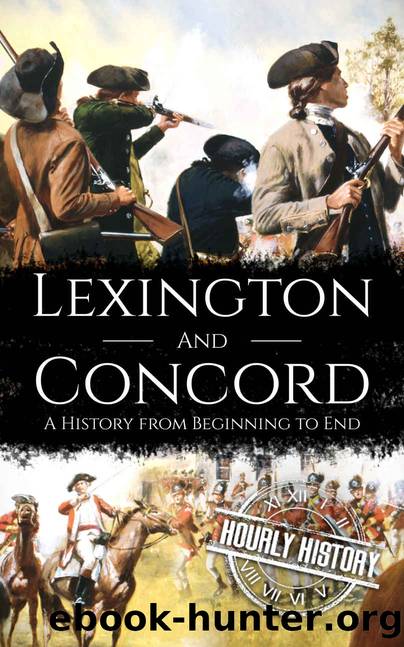Battles of Lexington and Concord: A History from Beginning to End (American Revolution Book 2) by Hourly History

Author:Hourly History [History, Hourly]
Language: eng
Format: azw3
Published: 2020-09-20T00:00:00+00:00
Chapter Five
The Battle of Concord
âWhoever looks upon them as an irregular mob will find himself much mistaken.â
âBrigadier-General Hugh Percy
The militias mustered in Concord to prepare for the British, but upon receiving reports that shots were being fired at Lexington, they didnât know what to do: wait for reinforcements from the neighboring towns, remain in Concord to defend it against attack, or move east, where they could have the advantage of better terrain for their fight.
A column of the militiaâs men, 250 in number, marched a little more than a mile on the road to Lexington. But upon encountering 700 British regulars, the column turned around to return to Concord, 500 yards ahead of the British coming behind them. They gathered at a ridge that overlooked the town. Then the men, led by Colonel James Barrett, crossed the North Bridge a mile north of Concord, to a hill that provided a vantage point from which to watch the British in the town. As they watched, their ranks grew in size as minutemen from the towns to the west arrived.
Meanwhile, the British in Concord were following the orders from General Gage. The grenadiers of the 10th Regiment secured the South Bridge. Seven companies of light infantry, one hundred men, claimed the North Bridge, unaware that they were being watched by the militias that were gathering. Four companies were taken two miles beyond North Bridge to search for hidden weapons, as intelligence reports from spies loyal to the British had told them where to look.
Two companies were stationed as guards for their return, and one company was set to the task of guarding the bridge. All the companies were under the command of Captain Walter Laurie. The British knew that their commanding officer lacked experience, and they also knew that they were outnumbered by the militia. Recognizing the dangers of the situation, Laurie sent a request for reinforcements to Lieutenant-Colonel Smith.
Meanwhile, the soldiers who were looking for the hidden weapons ordered Ephraim Jones, the proprietor of a tavern, to show them where a cannon was reportedly buried on his property. Jones had barred his door and refused entry to the troops, but the British were not going to be put off by a barred door. Major Pitcairn ordered Jones at gunpoint to reveal the hiding place of the three large guns capable of firing 24-pound shots and sufficient range to strike Boston. The British smashed the gun trunnions so that they couldnât be mounted, then burned gun carriages they found in the Concord meetinghouse.
The burning flames led to a fire, and one of the residents convinced the British to form a bucket brigade in order to save the building. Despite the hostile nature of the attack, the British were civil to the townspeople, even while searching for the munitions. The townspeople took advantage of the courtesy and steered the troops away from some of the weapons caches that remained in the town. Although Barrettâs Farm had been the storage site for weapons in
Download
This site does not store any files on its server. We only index and link to content provided by other sites. Please contact the content providers to delete copyright contents if any and email us, we'll remove relevant links or contents immediately.
| Africa | Americas |
| Arctic & Antarctica | Asia |
| Australia & Oceania | Europe |
| Middle East | Russia |
| United States | World |
| Ancient Civilizations | Military |
| Historical Study & Educational Resources |
The Dawn of Everything by David Graeber & David Wengrow(1577)
The Bomber Mafia by Malcolm Gladwell(1533)
Facing the Mountain by Daniel James Brown(1444)
Submerged Prehistory by Benjamin Jonathan; & Clive Bonsall & Catriona Pickard & Anders Fischer(1381)
Tip Top by Bill James(1302)
Wandering in Strange Lands by Morgan Jerkins(1288)
Evil Geniuses: The Unmaking of America: A Recent History by Kurt Andersen(1279)
Red Roulette : An Insider's Story of Wealth, Power, Corruption, and Vengeance in Today's China (9781982156176) by Shum Desmond(1268)
The Way of Fire and Ice: The Living Tradition of Norse Paganism by Ryan Smith(1263)
Driving While Brown: Sheriff Joe Arpaio Versus the Latino Resistance by Terry Greene Sterling & Jude Joffe-Block(1235)
American Kompromat by Craig Unger(1218)
F*cking History by The Captain(1200)
It Was All a Lie by Stuart Stevens;(1199)
Treasure Islands: Tax Havens and the Men who Stole the World by Nicholas Shaxson(1161)
American Dreams by Unknown(1160)
Evil Geniuses by Kurt Andersen(1154)
White House Inc. by Dan Alexander(1125)
The First Conspiracy by Brad Meltzer & Josh Mensch(1082)
The Fifteen Biggest Lies about the Economy: And Everything Else the Right Doesn't Want You to Know about Taxes, Jobs, and Corporate America by Joshua Holland(1035)
